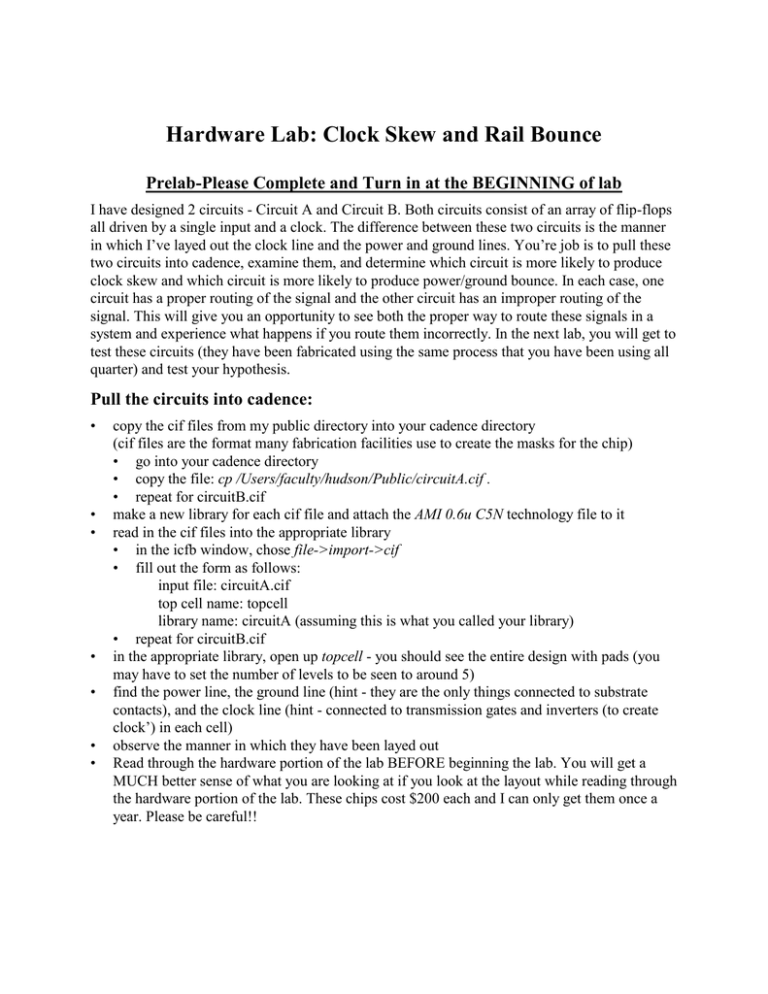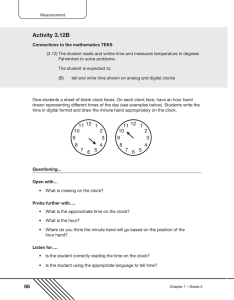Hardware Lab: Clock Skew and Rail Bounce
advertisement

Hardware Lab: Clock Skew and Rail Bounce Prelab-Please Complete and Turn in at the BEGINNING of lab I have designed 2 circuits - Circuit A and Circuit B. Both circuits consist of an array of flip-flops all driven by a single input and a clock. The difference between these two circuits is the manner in which I’ve layed out the clock line and the power and ground lines. You’re job is to pull these two circuits into cadence, examine them, and determine which circuit is more likely to produce clock skew and which circuit is more likely to produce power/ground bounce. In each case, one circuit has a proper routing of the signal and the other circuit has an improper routing of the signal. This will give you an opportunity to see both the proper way to route these signals in a system and experience what happens if you route them incorrectly. In the next lab, you will get to test these circuits (they have been fabricated using the same process that you have been using all quarter) and test your hypothesis. Pull the circuits into cadence: • • • • • • • copy the cif files from my public directory into your cadence directory (cif files are the format many fabrication facilities use to create the masks for the chip) • go into your cadence directory • copy the file: cp /Users/faculty/hudson/Public/circuitA.cif . • repeat for circuitB.cif make a new library for each cif file and attach the AMI 0.6u C5N technology file to it read in the cif files into the appropriate library • in the icfb window, chose file->import->cif • fill out the form as follows: input file: circuitA.cif top cell name: topcell library name: circuitA (assuming this is what you called your library) • repeat for circuitB.cif in the appropriate library, open up topcell - you should see the entire design with pads (you may have to set the number of levels to be seen to around 5) find the power line, the ground line (hint - they are the only things connected to substrate contacts), and the clock line (hint - connected to transmission gates and inverters (to create clock’) in each cell) observe the manner in which they have been layed out Read through the hardware portion of the lab BEFORE beginning the lab. You will get a MUCH better sense of what you are looking at if you look at the layout while reading through the hardware portion of the lab. These chips cost $200 each and I can only get them once a year. Please be careful!! Questions: 1. Which circuit will most likely cause clock skew? Why? 2. Which circuit will most likely cause power/ground bounce? Why? Hardware Lab - To be completed in lab on Friday Connect Board • • • • • connect a 5V power supply between the Vdd and Gnd pins • CHECK the polarity of the voltage with the multimeter!!! connect a 5V power supply between the PadVdd and Gnd pins • CHECK the polarity of the voltage with the multimeter!!! connect the function generator between the clk and Gnd pins • set function generator to square wave • set square wave to go from 0 to 5V using the amplitude and offset buttons • MEASURE the signal using the oscope BEFORE inserting your chip!!! • set the frequency to 1MHz connect a 1.5V power supply between the bias and Gnd pins • CHECK the polarity of the voltage with the multimeter!!! • (bias is used to power the off-chip buffers in the pads) plug circuitA into the zif socket • touch the ground terminal of the power supply BEFORE handling the chip!! • place the chip into the board so that the semi-circle is closest to the latch for the zif socket (A small square indicates where pin1 is located. Pin1 should be on the upper-right-hand side of the chip.) • look at your power supply - if it does not read 5V, you’ve probably put your chip in backwards!! • if the chip feels hot, you have probably put it in backwards!! • if you have put your chip in backwards, quickly take it out, let it cool, and pray you haven’t fried the chip!!! Test for Clock Skew • • • • • • • • measure the ClkOut signal using an analog probe of the oscope measure the clock input (clk) using the other analog probe of the oscope measure the rising and falling delay time between the clk signal and the ClkOut signal Please measure delay time by measuring the time from the input to reach Vdd/2 to the time for the output to reach Vdd/2 This measurement should give you the worst case delay for the clock on this chip. ClkOut is taken from the clock line at the longest distance from the clock input. repeat the previous 3 instructions with circuitB reinsert circuitA into the board raise the clock frequency to 5MHz. What happens to the output? What problem could this cause on the chip? move the clock frequency back to 1MHz. measure the effect that the clock has on the latching of data: (out1..out6 are the outputs of several flip-flops along the length of the clock line) • connect the digital scope pins as follows: pin0 -> clk pin1 -> In • • • • • • • • • pin2..pin7 -> out1..out6 turn on the digital scope trace (press the D7-D0 button) and turn off the analog scope trace (press the 1 and 2 buttons) set the scope to trigger on the input (In) (trigger->edge->D1) set the scope mode to normal (mode/coupling ->mode -> normal) set the scope to perform a single trace (press single button) flip the switch on the board, which changes the input. If nothing happens, switch it back. You should see traces D0-D7 appear on the oscope. (Which direction you need to move the switch depends on whether the scope is triggering on the rising or falling edge of the input). measure the delay for each output What clock edge should you measure from? Hint: this is a negative edge-triggered flip-flop insert circuitB into the board press the single trace button again flip the switch and measure the delay for each output for circuitB Test for Power/Ground Bounce • • • • • • • • • • • Leave circuitB in the board. measure VddOut using the analog scope probe (VddOut is taken from the power line at the longest distance from the power input) measure the clock input (clk) using the other analog scope probe reset the scope to continually update • turn off the digital scope trace and turn on the analog scope trace • reset scope to auto mode (mode/coupling -> mode -> auto) • reset scope to run mode (press the run/stop button) • set the scope to trigger on the analog clk input What effect does the clock have on the power rail? Why is this? (Hint: how did I layout each flip-flop?) Measure the amount of power bounce for circuitB. measure GndOut using the analog scope probe (GndOut is taken from the ground line at the longest distance from the ground input) Why does there not appear to be any ground bounce? Place circuitA into the board. move the analog scope probe back to VddOut Measure the amount of power bounce for circuitA. Summary of Questions Below is a summary of all the questions embedded in the text. Please answer the questions and turn this sheet in at the beginning of the next lab period. Name: _____________________________________________________ Clock Skew Delay time between clk and ClkOut: trisecktA_________________ tfallcktA__________________ trisecktB_________________ tfallcktB__________________ Describe what happens when the clock frequency is raised. Why is this a problem? Delay time between clk and outputs: CircuitA tdelay1_________________ tdelay2__________________ tdelay3_________________ tdelay4__________________ tdelay5_________________ tdelay6__________________ CircuitB tdelay1_________________ tdelay2__________________ tdelay3_________________ tdelay4__________________ tdelay5_________________ tdelay6__________________ Power/Ground Bounce What effect does the clock have on the power rail? Why is this? Power bounce measurement: circuitA___________________ circuitB____________________ Extra credit: Why does there not appear to be any ground bounce?





